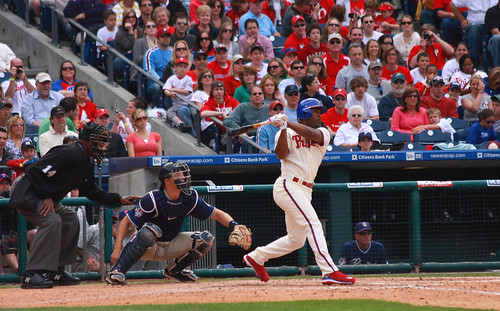It's been quite some time since the last time I had something significant to say. I figure I'll leave all the words that everyone shares for the other blogs out there. But this is a topic that I haven't seen tackled much, though many have recognized the problem. It is the death of integrity within the baseball broadcast booth.
Gone are the days of Ernie Harwell, Jack Buck, and Harry Kalas. Certainly, in their heyday, broadcasting a baseball game on television and radio was an art form. And yet, none of the great voices of our national pastime set out to become the legends that they now are. Instead, they focused on telling a story and depicting the images of our favorite game.
My father recollects that he would stay up late in the summer with his radio, able to pick up signals of almost every game east of the Mississippi. Perhaps he never knew the names of the men who delivered those games to his ears; but I wager that their notoriety was not paramount to my father or they themselves.
In this age, digital media has exploded and made it possible for anyone with an internet connection and a few bucks to see or hear baseball around the country in multiple languages. But the local broadcasters are worse than ever, with their national counterparts matching their ineptitude. So what is the problem? Why has broadcasting shifted from quality to quantity?
The way I see it, there are four reasons that broadcasting integrity has died:
1. Words, Not Names, Make Men: If you are a Hall of Fame baseball player, that makes you an expert at playing the game. Unfortunately it does not mean you would make a good coach or analyst. However, name recognition amongst broadcasters seems more important than ever. Sure, if you're a former ballplayer, you have more credibility than some guy named Joe on the street. But that doesn't mean you know any more about baseball than our friend Joe. Networks covering sports in general seem more concerned with the fame of analysts than their commentary contributions.
2. Information Overload: If you've never watched a Dodgers game before, do yourself a favor and watch one while you still have the opportunity to hear Vin Scully call a game. Several years ago, I tuned in to a game to hear nothing but the subtle murmur of the crowd for about a minute before Vin picked up the call of the game. The ability of a broadcaster to allow a game to "breathe" is crucial. Simplicity is beauty. Meanwhile, broadcasters today are busy trying to cram facts and stats and fun side stories into their commentary. Half the time, it seems they don't even know what's going on with the game itself. There's a reason they call it play-by-play, not story-by-story.
3. Lack of Due Diligence: There's one thing I hate more than being bombarded with stats during a game: being hit with inaccurate statements. Whether it's mispronouncing a player's name or asserting a fact about tendencies that just isn't true, nothing infuriates me more than hearing something wrong. National broadcasters tend to be the primary culprits of this crime, but local broadcasters can be just as guilty, especially when speaking about the visiting ball club. The first rule of journalism is to portray accurate facts to the best of your ability.
4. The Pursuit of Fame: This one is a little harder to quantify, but I believe it does happen. Harry Kalas had a very distinctive home run call. Jack Buck made many memorable calls, none bigger than of Kirby Puckett's World Series homer. These days, it seems many broadcasters are trying to find their own voice. They want to have a unique call or be recognized for their style or tone. Rather than deliver the game as it is presented to them, they instead force-feed themselves to the audience. And all that ruins the natural flow of the game.
What the death of broadcasting integrity really comes down to is a lack of respect for the greatest sport created. The golden ages of baseball were graced with players like Mays and Mantle and Koufax. During their great careers, there were equally great voices coloring us a picture of effortless swings, running catches, and dazzling fastballs. They respected the game.
Until baseball fans recognize and demand change in the fact that broadcasting no longer does the sport justice, they will continue to endure sub-par commentary.

